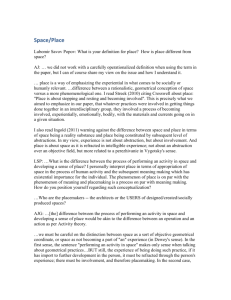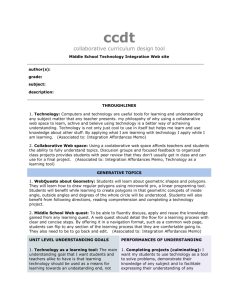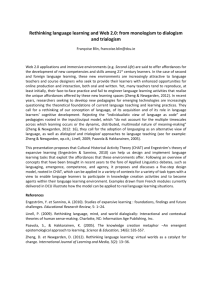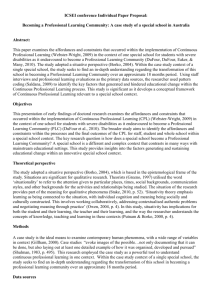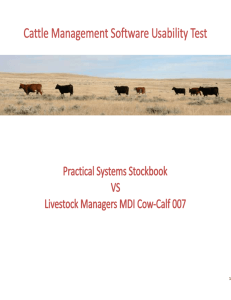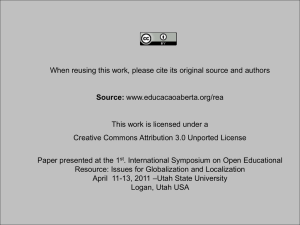- PhilSci-Archive
advertisement
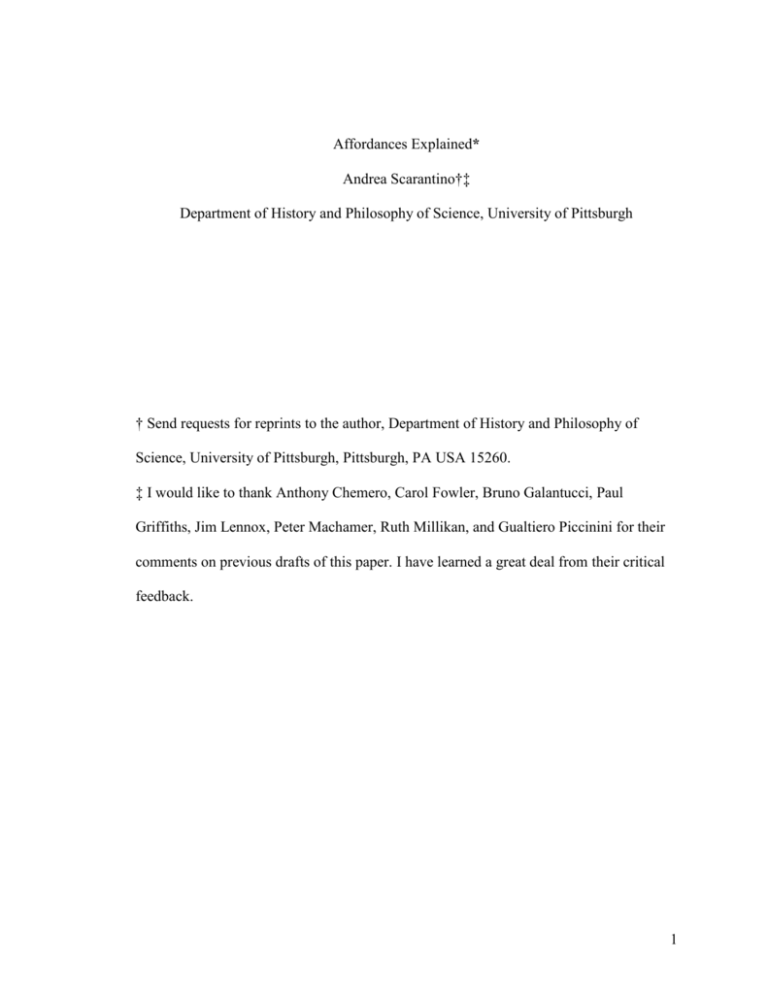
Affordances Explained* Andrea Scarantino†‡ Department of History and Philosophy of Science, University of Pittsburgh † Send requests for reprints to the author, Department of History and Philosophy of Science, University of Pittsburgh, Pittsburgh, PA USA 15260. ‡ I would like to thank Anthony Chemero, Carol Fowler, Bruno Galantucci, Paul Griffiths, Jim Lennox, Peter Machamer, Ruth Millikan, and Gualtiero Piccinini for their comments on previous drafts of this paper. I have learned a great deal from their critical feedback. 1 Abstract I examine the central theoretical construct of ecological psychology, the concept of an affordance. In the first part of the paper, I illustrate the role affordances play in Gibson’s theory of perception. In the second part, I argue that affordances are to be understood as dispositional properties, and explain what I take to be their characteristic background circumstances, triggering circumstances and manifestations. The main purpose of my analysis is to give affordances a theoretical identity enriched by Gibson’s visionary insight, but independent of the most controversial claims of the Gibsonian movement. 2 1. Introduction. The concept of affordance is the central theoretical construct of ecological psychology. It was introduced in its full-fledged form by James J. Gibson (1979) to account for what human and non-human animals perceive. The notion of affordances has recently been invoked in philosophical theories of mental content (e.g. Rowlands 1997; Bermudez 1998), but has yet to be submitted to sustained conceptual analysis. Notably, ecological psychologists themselves consider the notion of affordances still poorly defined (e.g. Stoffregen 2000). What I propose in this paper is firstly a critical interpretation of Gibson’s theory of affordances, and secondly an analysis of the peculiar dispositional nature of affordance properties. My ultimate objective is to provide a general framework for using the concept of affordance in the context of philosophical projects that may not share some of the assumptions and theoretical objectives of ecological psychology. 2. Gibson on Affordances. The concept of affordance is a theoretical concept, introduced by Gibson (1979) to play a role he believed no existing concept played in psychology: The affordances of the environment are what it offers the animal, what it provides or furnishes, either for good or ill. The verb to afford is found in the dictionary, but the noun affordance is not. I have made it up. I mean by it something that refers to both 3 the environment and the animal in a way that no existing term does. It implies the complementarity of the animal and the environment. (Gibson 1979, 127; emphasis in original) The affordances of the environment, Gibson suggested, are the offerings of the environment, roughly the sets of threats (negative affordances) and promises (positive affordances) that characterize items in the environment relative to organisms. Gibson sometimes used a characteristic linguistic construct to refer to affordances, namely [verb phrase]-able. For example, he described a surface such as the brink of a cliff as fall-off-able, a substance such as an apple as eat-able, an object such as a stone as throw-able, an animal such as a conspecific as copulate-with-able, an event such as a fire as cook-with-able. In each case, the affordance property is possessed by a bearer relative to a specific organism or class of organisms. Gibson introduced affordances to capture what he took to be the essential complementarity between organisms and environment. He believed such complementarity could be lost in two different ways, exemplified respectively by the languages of physics and phenomenology. Physics employs basic explanatory properties such as mass, charge, spin. These are paradigmatic objective properties, namely properties instantiated independently of any actual or potential response to the property bearer on the part of organisms. Every organism, Gibson thought, is a perceiver and a behaver, but “this is not to say that it perceives the world of physics and behaves in the space and time of physics.” (Gibson 1979, 4 8) What the organism is a perceiver of, and a behaver in, are environments (or niches). Gibson’s idea is that the organism and the environment make an inseparable pair, where each term has to be understood relative to the other. This inseparability brings along two desiderata for theories of perception and action. Firstly, the size-level of the physical world in which environments are carved must be the intermediate one between the cosmic and the atomic. Organisms perceive and behave in a world of objects measured in the scale of their body size (from fractions of millimeters to meters), and engage in activities occurring at the temporal scale of biological processes (from seconds to years). Secondly, the explanatory properties devised to understand perception and action must have a relational nature, where the two terms of the relation grounding the property refer respectively to the organism and to the environment. One way to discharge the two desiderata is the one favored by phenomenologists. Gibson did not define phenomenology, but indicated the Gestalt psychologists Kurt Lewin and Kurt Koffka as representatives of a relational approach he wanted to improve upon. Lewin (1935) and Koffka (1935) described objects in the environment in terms of what organisms can do with them. For instance, Koffka ascribed to a postbox the relational property of having a “letter mailing” demand-character. However, Gibson took phenomenologists to assume that the demand-character is “bestowed upon [the postbox] in experience, and bestowed upon it by a need of the observer.” (Gibson 1979, 138) Instead, he wanted to define affordances so as to be able to say that the postbox is lettermailing-with-able relative to an organism O independently of whether or not it is 5 perceptually experienced as such, and independently of whether or not, once perceived, it is attended to by O (this will be contingent upon O’s needs). As he put it, “an affordance is not bestowed upon an object by a need of an observer and his act of perceiving it.” (Gibson 1979, 139) What bestows affordances upon items in the environment, Gibson suggested, are a set of real, or objective, or physical properties of the affordance-bearer and the organism that are relevant to make a specific behavioral activity possible (e.g. grasping, catching, being eaten by). For example, Gibson (1979, 133) indicated that “to be graspable, an object must have opposite surfaces separated by a distance less than the span of the hand.” The properties that ground the threats and promises associated with affordance-bearers will have to be studied by a new ecological physics, whose explananda are perception-action couplings performed by organisms in environments. Some Gibsonians take the relevant physical properties to be relations between sizes of the body and sizes of the affordance bearer (e.g. Warren 1984). But it is clear that this is only a preliminary step in the attempt to ground affordances into the physical world.i As I will argue in the next section, an item X is grasp-able relative to O in virtue of O’s ability (or capacity) to grasp X, and such ability does not consist merely of the presence of a physical relation between the distance of X’s “opposite surfaces” and O’s “span of the hand” (e.g. the span of the hand of a person with a paralyzed open hand is unchanged, but the ability to grasp is lost).ii The inadequacy of mere body-scales to capture abilities becomes even more evident when the ability is, say, that of mailing a letter, or that of scoring a point. 6 We can now turn to some puzzling remarks Gibson made about the ontological status of affordances: An important fact about the affordances of the environment is that they are in a sense objective, real, and physical, unlike values and meanings, which are often supposed to be subjective, phenomenal and mental. But, actually, an affordance is neither an objective property nor a subjective property; or it is both if you like. An affordance cuts across the dichotomy of subjective-objective and helps us to understand its inadequacy. (Gibson 1979, 129) What Gibson wanted to say here, I take it, is that affordances are not subjective in the sense that they are bestowed upon the world in virtue of an actual or potential perceptual experience of a subject. In this respect, they are different from paradigmatic secondary properties such as colors, namely properties that are instantiated in virtue of a sensory response (a color experience) a subject would have, relative to the property bearer, in suitable circumstances. However, I would argue that affordances are similar to secondary properties with respect to their being response-dependent, namely instantiated in virtue of a behavioral response (e.g. a catching, a throwing) a subject would have, relative to the property bearer, in suitable circumstances. In the next section, I try to capture the nature of this responsedependency by unveiling the implicit dispositional nature of affordances. Under the view I 7 propose, the sense in which affordances are also objective is the sense in which a disposition in good standing has a basis constituted by objective properties. In this paper, I remain neutral on the issue of whether affordances really are the dispositional properties I describe in the next section (subjective in the sense of responsedependent) or, rather, the bases of such properties (objective in the sense of responseindependent). I just remark that, however we settle the ontological dispute, affordances represent a significant novelty with respect to the standard Lockean tri-partition between primary, secondary, and tertiary qualities.iii Before turning to the clarification of the dispositional nature of affordances, we need to focus on their relation to perception. Here are two relevant quotes on the matter: [P]laces, attached objects, objects, and substances are what are mainly perceived, together with events, which are changes of these things. To [perceive] these things is to perceive what they afford. (Gibson 1979, 240) The meaning or value of a thing consists of what it affords. (Gibson 1982, 407) The crucial empirical hypothesis of ecological psychology is that affordances are perceivable. Since affordances constitute, as claimed in the second quote, ecological meanings/values, the crucial hypothesis can be reformulated by saying that ecological meanings/values are perceivable. For example, to perceive the ecological meaning of a fire 8 would mean to perceive the fire as cook-with-able, or burning-by-able, etc. For Gibson, to perceive is to pick up information for purposes of behavioral discrimination (rather than for purposes of belief fixation). Gibson emphasized that this pick-up results from active exploration of the environment, it “can sometimes occur without the accompaniment of sense impressions,” (Gibson 1966, 2; emphasis added) and is always accompanied by perception of one’s own body (proprioception). But how do organisms pick-up information? To pick-up information, argued Gibson, is to become attuned to invariants and disturbances that specify to-be-perceived properties. An intuitive understanding of these technical notions is the following. An invariant is a property of the structure of ambient energy arraysiv (e.g. the optic array, the acoustic array, etc.) instantiated when, relative to some source of change such as a moving point of observation or a moving source of illumination, the structure is left unchanged in a way that is typical of the item specified (e.g. a reflectance can specify the substance “coal” by being unchanging in the way characteristic of coal substances). A disturbance is a property of the structure of ambient energy arrays instantiated when, relative to some source of change (e.g. the change constituted by an approaching predator), the structure presents a pattern of change that is typical of the item specified (e.g. the contour of an animal can specify the event “approaching predator” by changing in the way typical of approaching predators). In general terms, to say that affordances are perceivable is to say that there are invariants and disturbances in ambient energy arrays that specify the threats and promises of items in the environment. For example, to say that the eat-ability of a given apple is perceivable, or 9 that the being-hit-by-ability of a flying ball is perceivable is to say that there is a sensory appearance - a way to be visible/audible/tangible/odorous/tastable - typical respectively of apples affording eating, and of flying balls affording being hit by. Gibson was very clear that we cannot establish “a priori” what affordances are specified in ambient energy. v As he put it, “[t]he central question for the theory of affordances is not whether they exist and are real but whether information is available in ambient light for perceiving them.” (Gibson 1979, 140) Information is available for perceiving all and only those offerings of the environment that are associated with typical sensory appearances. In some cases, the organism will have to learn to perceive a perceivable affordance, i.e. learn to become attuned to the invariant or disturbance specifying it. What invariants and disturbances are in fact available for the specification of affordances will have to be established by empirical investigation. The most controversial part of ecological psychology has to do with the way in which Gibsonians cash out the notion of becoming attuned to invariants and disturbances. On the one hand, they assume that invariants and disturbances carry information about affordances by lawfully specifying them.vi The idea is that a law of nature links properties of the structure of ambient energy arrays and affordances. On the other hand, Gibsonians think that the presence of a lawful specification is such that the pick-up of information for affordances can occur without the involvement of mental representations and mental processes involving representations (e.g. inferences, computations, retrievals of memories, etc.). vii This is what lies behind the trademark claim of ecological psychologists that perception is direct. 10 I think these two related moves are highly questionable.viii However, I won’t argue for this point here. As I pointed out, affordances are what they are independently of whether or not they are perceivable (some may not be), and independently of how they are eventually perceived (directly or indirectly). At the same time, the relevance of affordances for the explanation of behavior crucially hinges upon their perceivability. Before reflecting on the relation between affordances and perception, we need a more thorough understanding of what it means to ascribe an affordance to a bearer. Once we have settled what kinds of properties qualify as affordances, we can then discuss whether, relative to some theory of perception T, such properties are perceivable. One of the objectives of my paper is to make affordances available as potential objects of perception for theories of perception that may not share Gibson’s radical rejection of mental representations and mental processes as useful explanatory constructs. 3. Affordances as Dispositions. 3.1 The Semantics of Dispositions. Since I want to argue that affordances are a species of dispositional properties, I need an account of the genus. However, philosophical controversies flourish concerning what properties are, and what makes them dispositional. Given the space constraints on this paper, I can only proceed stipulatively, and refer the reader to some relevant authors who clarify and defend the working assumptions I make. 11 Firstly, I take a property to be “the set of all its instances - all of them, this- and otherworldly alike.” (Lewis 1986, 50) Secondly, I assume that properties are abundant in David Lewis’ sense, namely as “extrinsic, as gruesomely gerrymandered, as miscellaneously disjunctive as you please.” (Lewis 1986, 59) Thirdly, I assume that to clarify the meaning of properties is to clarify the semantics of the predicates (if any) expressing them. Fourthly, I follow Stephen Mumford (1998) in thinking that a predicate is dispositional or categorical depending on the way in which its ascription entails subjunctive conditionals.ix Let us take two paradigmatic examples from the classes we want to distinguish, namely fragility and triangularity. The ascription “X is fragile” entails the subjunctive conditional “if X were (suitably) hit, then X would break”, and the ascription “X is triangular” entails the subjunctive conditional “if X’s sides were (suitably) counted, the result would be three”. x This shows that we cannot simply draw the distinction by saying that dispositional ascriptions, differently from categorical ones, entail subjunctive conditionals. What Mumford (1998, 77) indicates as the fundamental ground of difference is that the entailment is by conceptual necessity in the case of fragility, but not in the case of triangularity. Roughly speaking, the idea is that the subjunctive conditional captures what being fragile means, whereas it does not capture what being triangular means (although is captures something that necessarily follows from what being triangular means). To defend Mumford’s (1998) account 12 would of course require a convincing defense of the notion of conceptual necessity. Here, I simply assume that Mumford’s way of drawing the distinction can successfully be defended. Fifthly, I adopt from Elizabeth Prior (1985) the idea that dispositional predicates are best thought of as incomplete predicates. In the case of classic dispositions such as fragility, solubility, flammability, and so on, she suggests that the completer is a set of background circumstances C. In other words, a bearer X is or is not fragile, or soluble, or inflammable not simpliciter, but given C. For example, the very same object X may be, say, fragile given a background temperature of -170C, and not fragile given a background temperature of 30C. 3.2 What Kinds of Dispositions are Affordances?. I take predicates such as climb-able, reach-able, letter-mailing-with-able, bump-into-able and so on to be dispositional predicates.xi To clarify the semantics of an affordance ascription of the general form “X has affordance property A (at time t relative to an organism O in circumstances C)” is to fill-in placeholders in a subjunctive conditional conditional that is entailed by the affordance ascription by conceptual necessity. Such conditional conditional has the following general form:xii At time t, if background circumstances C were the case, then [if a set of triggering circumstances T were the case, then a manifestation M involving X and O would be the case (with probability p)]xiii 13 Under this view, affordance predicates are time-indexed incomplete predicates, whose completer is a set of background circumstances referring to an organism at a time in a set of environmental circumstances. For example, a tree X is climbable/not-climbable not simpliciter, but at time t relative to squirrel O in background circumstances C. Such circumstances would include, among other things, that the squirrel O is not surrounded by a structure that prevents his movements, and that the tree X is not on fire. Two insights concerning C have to be kept in mind from the literature on dispositions. The first is that the background circumstances C under which a disposition is possessed cannot be listed exhaustively, because they consist of an indefinitely large set. In fact, there is always some condition c that could be added to a specified set C such that, given C & c, any object X would no longer possess any given disposition (e.g. there are conditions under which sugar is not water-soluble, Ming vases are not fragile, etc.). The second is that the list of background circumstances C cannot be left entirely open-ended, because there is presumably always some set C such that, given C, almost any object X would possess almost any disposition (e.g. there are conditions under which bars of steel are soluble, pieces of diamond fragile, etc.). How should set C be accounted for then? A full discussion would take us too far, but the general idea I endorse is that, for what concerns affordance predicates, we should rely on a tacit understanding of C as the set of normal ecological circumstances.xiv Let me just mention that a basic desideratum for any theory of normal ecological circumstances is the avoidance of vacuity, which would result for example from defining conditions C as 14 ecologically normal just in case nothing interferes with the affordance being possessed. What a theory of normal circumstances has to account for is how to sort, within the class of potential defeaters of affordance manifestations, those that are, and those that are not compatible with the affordance being possessed by X relative to O. In other words, the avoidance of vacuity demands a tacit understanding of the difference between failures of manifestation of a truly ascribed affordance, and evidence that the affordance is falsely ascribed. The trademark feature of affordances is that their manifestation is always constituted by an event in which the affordance-bearer X and the organism O are both involved.xv If we look at Gibson’s examples of affordances, we notice manifestations such as climbing, catching, getting under, eating, mailing a letter, but also such as bumping into, getting burned by, falling off, being eaten by. Whereas events in the first list constitute things organisms do, events in the second list constitute things that happen to them. The distinction is in my view important enough to distinguish between two classes of affordances, namely goal-affordances (their manifestation is a doing) and happeningaffordances (their manifestation is a happening). What makes an organism-involving event a doing rather than a happening is how the manifestation is related to the triggering circumstances. In the philosophy of action, the doing/happening distinction is commonly cashed out in terms of the distinction between events that respectively are and are not intentional under some description (Davidson 1980, 61). In other words, actions are typically understood as events triggered by an intention, and such that there is a description of the 15 event under which the intention is fulfilled (in the right way). But this distinction can at best help us sort goal-affordances from happening-affordances relative to human organisms, namely organisms capable of the kind of conceptual achievement demanded by formulating an intention, for I take intentions to be propositional attitudes beyond the reach of, say, bacteria. What we need are distinctions that apply at lower levels, namely at all levels of organismic life relative to which we want our affordance concept to apply. I provisionally distinguish between doings and happenings as events that respectively are/are not goalachieving under some description. Roughly speaking, doings are events triggered by the selection of a goal, and such that there is a description of the event under which the goal is achieved (in the right way). I leave it an open question for now how to characterize precisely the notions of selecting and achieving a goal in the right way for various classes of organisms, a topic that would demand more attention than I can devote to it here.xvi Under the view I am proposing, if it is true that, given background circumstances C, an organism O can at t engage in an event that qualifies as a doing or a happening M and involves X, then X is at t an affordance-bearer with manifestation M relative to O in circumstances C.xvii This being the case, an important determinant of what counts as an affordance property is how we interpret the modal force of “O can at t”. To simplify, I will elaborate the point only with respect to goal-affordances (but a similar story can be told about happening-affordances). 16 To establish what an organism O can do at t is tantamount to establishing what O’s abilities are at t.xviii A distinction is for example the one between a current ability – e.g. I am now able to sit – and a latent ability – e.g. I am now not able to juggle, but I could learn. Another distinction is the one between degrees of reliability of current abilities. For example, whereas I am currently highly reliable at sitting when I select it as a goal, I am much less reliable at catching, and I manage to ride a unicycle about once every 10 times I try. The decisions we make with respect to how to count O’s abilities at t - what O can do at t -, will determine the extension of the class of goal-affordances relative to O. I propose to restrict affordance-bestowing capacities to current capacities of individual organisms. The subjunctive conditional entailed by conceptual necessity by the ascription of goal-affordances will then have the form “at t, if background circumstances C were the case, then if organism O were to select the goal of [climbing, grasping, letter mailing, etc.], then the manifestation of [climbing, grasping, letter mailing, etc.] would occur with positive probability p.” Under this view, when we describe a tree X as climb-able for an organism O at t, what we are saying is that, given (tacitly understood) normal ecological conditions, O would succeed at climbing X with some positive probability p were O to try climbing at t. O’s latent ability to climb, I suggest, should not be considered sufficient to ascribe climbability at t relative to O (but the tree X may become climb-able relative to O at some later time t’, if O’s latent ability becomes current at t’). But is really any positive probability p enough for ascribing affordances? The answer here is open, it all depends on the theoretical uses we want to make of the affordance 17 concept. My inclination is to restrict affordance-bestowing current abilities to reliable current abilities, namely abilities such that the probability of success given a try is not only positive but also significant (the reliable/unreliable boundary will of course be blurred). But I will not discuss this preference here, and conclude by introducing a terminological distinction between affordances with respect to the degree of reliability of their underlying abilities. I distinguish between surefire-affordances, i.e. affordances such that the manifestation follows the triggering circumstances with certainty, and probabilistic-affordances, i.e. affordances such that the manifestation follows the triggering circumstances with some positive probability p less than 1. Sit-ability is now for me a candidate surefire goalaffordance, and catch-ability and ride-with-ability are now for me probabilistic goalaffordances of different degrees of reliability.xix Notice that the surefire/probabilistic distinction applies to both goal-affordances and happening-affordances. Many of the latter seem in fact to be of a probabilistic variety (e.g. the brink of a cliff possesses the probabilistic affordance of fall-off-ability). 4. Conclusion. In the first part of this paper, I have tried to clarify Gibson’s theory of affordances, with special focus on their relational nature, and their status as potential objects of perception. In the second part, I have analyzed the dispositional character of affordances, introducing a few hopefully useful distinctions between kinds of affordances. I now want to conclude by 18 pointing the reader to an opportunity and a risk we face by allowing affordances in our explanatory toolbox. The opportunity, a tantalizing one in my opinion, is that of acquiring an instrument to account for objects of perception imbued with a kind of meaning – ecological meaning – that we can legitimately suppose to be grasped in a similar way by animals, infants, and adult human beings, at least with respect to some affordances. For example, it seems quite possible that, despite their cognitive differences, an animal, a child, and an adult person may perceive the brink of a cliff as fall-off-able according to a common perceptual process. What I am suggesting is not that they may all similarly perceive that the brink of cliff is fall-off-able, but rather that they may all similarly engage in a perceptually guided behavioral discrimination of the brink of the cliff as fall-off-able. The risk to be avoided is the assumption that this commonality of perceptual processing extends uniformly across the board. Let us focus on human goal-affordances. As I pointed out before, the domain of goal-affordances is complementary to the domain of actions or doings individuals can perform. The category of human actions includes mental actions (e.g. dividing a number by two) and physical actions. The latter category is commonly divided between basic physical actions (bodily movements, e.g. catching a ball) and non-basic physical actions (consequences of bodily movements, e.g. scoring a point by catching a ball). There is no reason to assume that a theory of perception can explain in the same way how humans perceive, if they do, a number being divide-by-two-able (a mental affordance), a flying ball being catch-able (a basic physical affordance), and a flying ball being score-with- 19 able (a non-basic physical affordance). Whereas catch-ability seems suitable for being grasped in a similar way by language-using and non-language-using creatures, divide-by-twoability and score-with-ability demand a story about perception in which the languagemediated ability to master concepts such as divisible number or point in a game will play a prominent role. This is just to say that affordance properties ought not be treated by default as a homogenous block by theories of perception. They inherit from their constitutive relations with kinds of doings and kinds of happenings a number of distinguishing properties that are potentially relevant to establish whether they are perceivable, and, if they are, how they are perceived. 20 REFERENCES Barker, Stephen (1999), “Counterfactuals, Probabilistic Counterfactuals and Causation”, Mind 108(431): 427-469. Bermúdez, José Luis (1998), The Paradox of Self-consciousness. Cambridge: MIT Press. Chemero, Anthony (Forthcoming), “An outline of a theory of affordances”, Ecological Psychology. Davidson, Donald (1980), Essays on Actions and Events. New York: Oxford University Press. Fodor, Jerry, and Zenon Pylyshyn (1981), “How Direct is Visual Perception? Some Reflections on Gibson’s ‘Ecological Approach’”, Cognition 9: 139-196. Gibson, James J. (1966), The Senses Considered as Perceptual Systems. Boston: Houghton Mifflin. . (1979), The Ecological Approach to Visual Perception. Boston: Houghton Mifflin. Gibson, James J., Edward Reed, and Rebecca Jones (1982), Reasons for Realism: Selected Essays of James J. Gibson. Hillsdale: L. Erlbaum. Koffka, Kurt (1935), Principles of Gestalt Psychology. New York: Harcourt Brace and Company. Lewin, Kurt (1935), A Dynamic Theory of Personality: Selected Papers. New York: McGraw-Hill. Lewis, David (1986), On the Plurality of Worlds. Oxford: B. Blackwell. 21 Locke, John ([1690]1975), An Essay Concerning Human Understanding. Edited by Peter H. Nidditch. Oxford: Oxford University Press. Mellor, Hugh (1974), “In Defense of Dispositions”, Philosophical-Review 83: 157-181. Millikan, Ruth (1984), Language, Thought and Other Biological Categories. Cambridge MA: MIT Press. . (2000), On Clear and Confused Ideas. An Essay about Substance Concepts. Cambridge: Cambridge University Press. Mumford, Stephen (1998), Dispositions. Oxford: Oxford University Press. Prior, Elizabeth (1985), Dispositions. Aberdeen: Aberdeen University Press. Rowlands, Mark (1997), “Teleological Semantics”, Mind 106(422): 279-303. Stoffregen, Thomas (2000), “Affordances and Events”, Ecological Psychology 12(1): 1-28. Turvey, Michael, Robert Shaw, Edward Reed, and William Mace (1981), “Ecological Laws of Perceiving and Acting: In Reply to Fodor and Pylyshyn”, Cognition 9: 237-304. Turvey, Michael (1992), “Affordances and Prospective Control: an Outline of the Ontology”, Ecological Psychology 4(3): 173-187. Warren, William (1984), “Perceiving affordances: Visual guidance of stair-climbing”, Journal of Experimental Psychology: Human Perception and Performance 10: 683– 703. Wells, Andrew (2002), “Gibson's Affordances and Turing's Theory of Computation”, Ecological Psychology 14(3): 141-180. 22 FOOTNOTES i See Chemero (Forthcoming) for an empirically informed discussion of the relation between body scales and abilities. My discussion of this point is indebted to him. ii Ecological psychologists who appreciate the fundamental complementarity between affordances and abilities call the latter effectivities (e.g. Turvey et al. 1981). iii Locke ([1690]1975, II, viii, 23) famously distinguished between primary qualities of bodies, which are “in the things themselves, whether they are perceived or not” (e.g. bulk, motion), secondary qualities, i.e. powers “to operate after a peculiar manner on any of our Senses” (e.g. color, smell), and tertiary qualities (Powers in Locke’s text), i.e. powers to “make . . . a change in the Bulk, Figure, Texture, and Motion of another body” (e.g. the power of the sun to melt wax). “To be an array means to have an arrangement, and to be ambient at a point means to iv surround a position in the environment that could be occupied by an observer” (Gibson 1979, 65). v Gibson (1979)’s main focus was on ambient light, but his account must be generalized, because an affordance could be specified despite lacking a typical way to look (it may have a typical way to, say, sound and/or smell). vi See for example Turvey et al. 1981, 267-275. vii See for example Gibson 1979, 238-263. 23 viii See Fodor and Pylyshyn 1981 for a critique of the directness of Gibsonian perception, and Turvey et al. 1981 for a response. As Prior (1985, 5) puts it, “[w]hat is commonly accepted by all those who discuss ix dispositions in that there exists a conceptual connection between a statement attributing a disposition to an item and a particular conditional”. A significant portion of the philosophical debate on dispositions focuses on whether the truth conditions of disposition ascriptions can adequately be captured in terms of conditionals. x The triangularity example was introduced by Mellor 1974. xi The idea that affordances are dispositions has already been explored by members of the Gibsonian movement, most notably Turvey et al. 1981 and Turvey 1992. The main problem with such contributions is that they introduce the idea that affordances and abilities are complementary and dispositional, but fail to explain what kinds of dispositions they are. The clarification of the semantics of dispositional predicates demands making explicit the subjunctive conditionals associated with them. See Wells 2002 for a critical review of existing accounts of affordances. xii To simplify matters, I am assuming that the bearers of affordances are individual items, but this is not always the case. For example, a bow X1 and an arrow X2 can be shoot-with-able relative to some O only jointly. 24 xiii The expression conditional conditional is in Mumford 1998, 88. I assume both if-then conditionals to be subjunctive, and the probability p to be objective. See Barker 1999 for an account of the truth conditions of subjunctive conditionals when the consequent is chancy. xiv See for example Mumford 1998, 87-92 for an account of normal circumstances as ideal circumstances relative to the context of ascription. For an alternative, see Millikan’s 2000, 64-68 account of normal circumstances as historical circumstances relative to a selectionist history, namely circumstances in which the ability expressed in the affordance manifestation – e.g. climbing – was selected for (see also Millikan 1984, chapters 1 and 2). xv For the purposes of this paper, I am endorsing Davidson’s (1980) ontology of events, according to which events are dated and located “unrepeatable particulars” (Davidson 1980, 181) with the following identity condition: “events are identical if and only if they have exactly the same causes and effects” (1980, 179). xvi The challenge is to clarify what makes a sequence of bodily movements an action, rather than a happening, in the absence of the ability to engage in the propositional representation of the condition whose fulfillment constitutes the achievement of the goal. Under this view, fulfilling an intention would be a special case of achieving a goal, a case associated with the fulfillment of satisfaction conditions whose grasp is available to the acting organism in propositional form. 25 xvii I am using the notion of involvement loosely here, referring to forms of interaction between O and X as diverse as O’s catching X, O’s being hit by X, O’s eating X, O’s falling off X, etc. xviii I am thinking of having an ability in the sense of being able to, rather than in the sense of knowing how to. See Millikan 2000, 54 for a brief discussion of this distinction. Millikan (2000, 51-68) argues that having an ability in the sense of knowing how to is not a disposition, but it implies a disposition. xix It is an open question whether there actually are any surefire-affordances. 26
